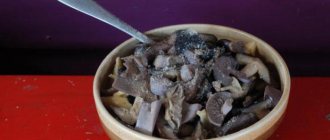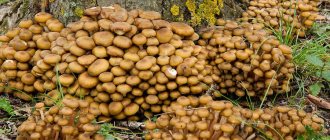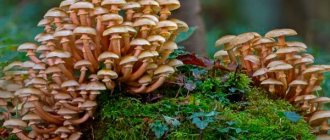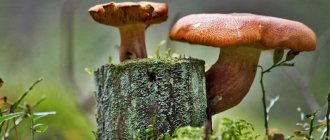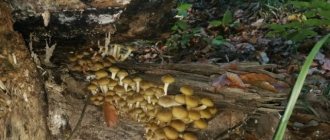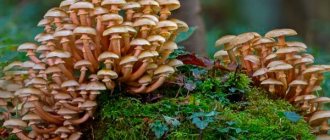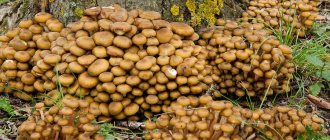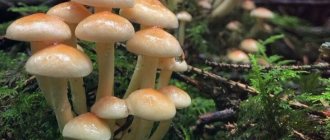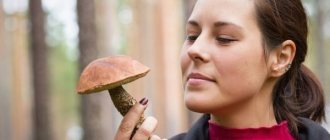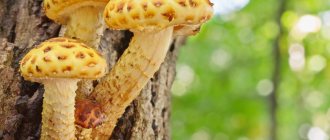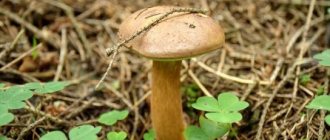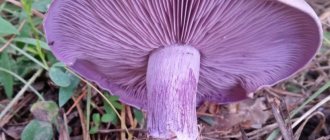Translated from Latin, openok means “bracelet”. Not surprisingly, if you look closely at the stump on which the mushrooms have sprouted, you will notice that the colony is arranged in the shape of a ring.
There are several varieties of this mushroom:
- Summer honey fungus. It grows in colonies on broken or dead wood. It has excellent taste and is grown in huge quantities.
- Autumn honey fungus. It grows both on stumps and on broken or living trees. The stem reaches 10 cm in height and 2 cm in diameter. Fruiting is gradual, occurring every 2-3 weeks.
- Winter honey fungus. The fungus is usually found on rotten willow or poplar. The leg is from 2 to 7 cm in height. The cap is 2-10 cm. Growth season is late autumn-winter.
- Meadow honey fungus. It is found mostly in ravines, forest clearings and on roadsides near roads. The leg is quite thin, up to 10 cm in height.
Summer honey mushrooms: description
People call them thief, talker, and linden honey fungus. Kyneromyces variable. Honey mushrooms got their “name” due to the fact that they grow near stumps.
External indicators:
- Hat. It is distinguished by drooping edges, brown or light brown coloring with a light tubercle in the center. The size of the cap varies from 2 to 8 cm (diameter), the surface is mucous, therefore, with high air humidity, leaves, grass, etc. are stuck on it. In young mushrooms, the cap has bulges, in older ones it is flattened.
- Leg. The diameter is 0.5 cm, the length is from 3.5 to 8 cm. The shape is cylindrical with a bend, the color is light closer to the cap, but as it goes down the leg becomes dark brown. The surface is covered with microscopic scales and there is a ring.
- Hymenophore. At the bottom of the cap there are plates. When young they are beige, when old they are brownish. The hymenophore is covered with a cobwebby substance, the spore powder is dark brown.
- Pulp. The inside of the leg is hard, so it is not eaten, and the flesh of the cap is soft. The smell is woody, the cut is watery, the color is pale yellow to brown.
Yellow-red honey mushrooms
Despite the unusual color, yellow-red honey mushrooms are classified as edible mushrooms. Unlike their counterparts, they have a velvety coating on the cap, a cylindrical stem shape and an increased length from 6 to 12 cm. Less commonly, larger families are found, but they are old. You can eat them, but only in canned form.
Varieties
There are a huge number of species of honey mushrooms. Each of them has its own characteristics, taste and external characteristics. Among them there are both edible and poisonous specimens, so it is important to learn to recognize the varieties.
Honey fungus
Meadow mushrooms are found mainly in open space - meadow, pasture, clearing, field, etc. They are localized among the grass on the soil. The growing season is from the last days of May to the end of October, so the mushroom is considered a summer mushroom.
Peculiarities:
- cap diameter – from 3 to 5 cm;
- shape – hemispherical convex;
- shade - from light ocher to light red;
- surface – smooth;
- the plates are sparse, ocher in color in sunny weather, creamy white in rainy weather;
- leg – from 3 to 10 cm in length, thin, velvety, ocher;
- pulp – light sweet;
- taste – clove;
- spore powder – light.
In dry weather the cap becomes drooping, but if it is placed in water, its elasticity returns.
Udemanciella mucosa
The peculiarity of this species is that it does not grow in colonies, but singly or grows together with legs of a maximum of 3 mushrooms. Place of growth - wood in broad-leaved forest. Growth time is July-November.
Short description:
- cap diameter – from 2 to 10 cm;
- shape – first hemispherical, then flat;
- color – light gray at the edges, brownish towards the center;
- surface – mucous;
- plates – sparse and white;
- leg – 5-8 cm, covered with brown-black scales;
- spore powder – whitish;
- pulp – white;
- the ring is ribbed and movable.
Udemansiella mucosa does not have a distinct smell or taste, so the mushroom is prepared together with other types of honey mushrooms.
Honey fungus thick-legged
The species grows among rotten leaves, on stumps that are rotting and dying trees. The harvest is harvested from early August to late October.
Characteristic:
- cap diameter from 2.5 to 10 cm;
- shape – broadly conical at first, flattened later;
- color – from pink to dark brown;
- surface – scaly;
- plates – frequent;
- leg – up to 8 cm in length, cylindrical in shape with club-shaped thickenings;
- the pulp and spore powder are white.
The mushroom has an unpleasant damp smell and astringent taste.
Autumn thick-legged honey fungus
It differs from the usual autumn honey fungus in having a thicker leg at the base, its color is almost identical, but at times it is somewhat lighter and paler, and sometimes with light scales instead of dark ones. In addition, this mushroom looks stronger and does not grow in large clusters, but throws out fruiting bodies in groups of no more than a dozen. Not seen on living trees; it feeds on rotting plant debris, so it can more often be found on windbreaks and forest floors.
Fruits from August to October - evenly, without “layers”. In particularly warm years, fruiting bodies may appear as early as July. It is edible and is not inferior in taste to ordinary autumn honey fungus.
Dangerous twins
There are varieties of summer honey fungus that are prohibited from being eaten, as they are false doubles. In our country, 4 types of such mushrooms are most often found.
False honey fungus brick-red
The mushroom is considered conditionally edible, but there is no exact scientific evidence about its poisonous properties. There is information that gastrointestinal poisoning occurs after its consumption. Many mushroom pickers collect brick-red honey fungus, but soak it for a long time before cooking.
How to recognize:
- place of growth - rotting deciduous trees;
- growth time - from early July to late October;
- cap diameter – from 2 to 7.5 cm;
- shape – initially bell-shaped, then flat-convex;
- surface – smooth with a tubercle in the center (but may be without it);
- ring – missing;
- color – brick red with a light cream tint on the edge;
- leg – yellow-brown, up to 10-12 cm long;
- the pulp is yellowish and fleshy;
- taste – has bitterness;
- the plates are frequent, notched and fused.
The older the mushroom, the darker it becomes - up to a black-brown or brown-green hue.
False honey fungus sulfur-yellow
The mushroom is considered poisonous, so eating it is strictly prohibited. Intoxication of the body is noted after 1-5 hours. Manifested by nausea and vomiting, increased sweating and loss of consciousness.
External indicators:
- place of growth - rotting deciduous and coniferous trees, stumps, soil;
- growing season - from the last days of May to November;
- cap – in diameter from 2 to 7 cm;
- color – from yellow-brown to sulfur-yellow;
- shape – bell-shaped at first, flat later;
- pulp – white or yellowish;
- taste – very bitter;
- smell – earthy and unpleasant;
- leg – up to 10 cm long, straight in shape, fibrous structure;
- plates – thin and frequent, greenish, yellow or olive;
- spore powder – brown-chocolate;
- the ring on the stem is missing.
Psatirella Candolla
The mushroom is considered conditionally poisonous, since in the literature of the last century it is indicated that it is poisonous; in modern publications there is information that Psatirella Candolla is allowed to be consumed, but after cooking.
Characteristics:
- grows both on rotting and living trees, in soil, on stumps;
- growth period - from late May to September;
- cap diameter – from 3 to 8 cm;
- color – cream, matte;
- structure – cracking;
- shape – conical initially, flat later;
- edges – wavy, sinuous;
- the surface is smooth, but small scales periodically appear and immediately fall off;
- leg – very thin (maximum 0.6 cm), up to 9 cm long;
- plates – brown-violet, frequent;
- pulp – white, fragile;
- ring - present only in young mushrooms;
- smell and taste – mushroom;
- spore powder is brownish-violet.
Psatirella water-loving
It is considered a conditionally poisonous mushroom. Grows on deciduous trees, sometimes found on needles. It is also localized in the ground, but exclusively near stumps.
How to recognize Psathirella water-loving:
- cap – convex, bell-shaped with a diameter of up to 4-6 cm;
- color - brown-cream or chocolate (depending on the weather - the latter option during rain);
- Fruiting period - from early June to mid-October;
- leg – up to 6-8 cm, hollow and curved;
- the pulp is brown and hard;
- surface – hygrophanic;
- taste – soft;
- smell – absent;
- ring – yes;
- plates – frequent, fused, color from light brown to brown-black;
- spore powder is brownish-violet.
Autumn bulbous honey fungus
It is very similar to the previous mushroom (as well as to other autumn mushrooms), especially with a stalk, which has a characteristic tuberous swelling at the very base - but usually those mushrooms that grow on trees, those that appear on the ground, have a “standard” stalk ", thin. However, the cap of the bulbous honey fungus is usually noticeably darker than the stem, and the color of the entire fruiting body is often quite bright, varying from brown to outright yellow tones.
The bulbous honey fungus bears fruit from August to September (the peak of fruiting occurs in the second month), usually appears in deciduous forests in a friendly layer on dead wood, old stumps and rotted wood debris.
Photo 8. Young fruiting bodies of the bulbous honey fungus on mossy dead wood. Author: Tony Hisgett.
In terms of edibility, it is somewhat inferior to real honey fungus (this is especially true for frail fruiting bodies growing on the soil). Mushroom pickers who know a lot about honey mushrooms note that it is better to throw away the very bottom part of the stem - it is, as a rule, especially hard and has completely unsightly nutritional qualities.
Season and habitat
Summer honey mushrooms prefer deciduous and mixed forests, where there are many rotten stumps and rotten wood. They can also grow in clearings and mountainous areas. Favorite trees are linden, birch, hazel, oak, but it is found on any species, including conifers.
It grows in all latitudes, except the Far North, and bears fruit from early April to late October, depending on climatic and weather conditions. In the South you can harvest all year round.
Summer honey fungus is one of the parasites that establish their countless colonies on trunks and stumps, clinging to them on all sides and moving to the very top of the tree.
Places of distribution and time of collection
In mid-May, summer honey mushrooms ; they are sometimes called spring mushrooms. The species is found until the beginning of September, quite often among humid forests, appearing in large colonies on deciduous wood. It is advisable to collect them by cutting off the caps alone, since the hollow thin stem is hard, fibrous, and has no nutritional value.
meadow honey mushrooms appear singly or even in groups , flashing a warm yellow-brown color among the grass in forest clearings, pastures, along paths and ravines. Harvests can be harvested before the beginning of autumn.
The end of August and the time of the first drizzling rains is the time to collect real or autumn honey mushrooms . It is easier to find them on birch and aspen wood - on stumps and old trees. These perky mushrooms are collected until late autumn. The frost can already silver the grass, but they are still visible on the stumps.
winter honey mushrooms appear , appearing in fused groups on fallen trees and stumps of poplars, willows and maples. Their appearance is a sign of a weakened or old tree. You can find them in forests, parks, old orchards, and artificial plantings. Fruiting bodies are collected not only throughout the fall before the onset of winter and severe frosts, but also during winter thaws, until the arrival of the real May warmth.
Features of collection
Mushroom pickers look for summer mushrooms in hard-to-reach places; sometimes you need to look into a hollow, but it must be rotten. There are rules for collecting these mushrooms that must be followed:
- never damage the mycelium, otherwise the entire colony will die out, so do not pull them out, but cut them off with a sharp knife or simply unscrew the mushroom, turning it around its axis;
- after cutting, sprinkle the mycelium with soil and lightly compact it;
- look for mushrooms with a long stick (1-1.5 m);
- The most delicious honey mushrooms are young ones, but do not touch specimens that are too small;
- if you see a small cluster of mushrooms, do not leave, as you can find a whole colony very close by;
- do not place cut honey mushrooms in a container such as a bucket - it is better to take a basket, which will allow air access to the mushrooms;
- fold with the caps towards the top and the legs towards the bottom - this way the mushrooms will not be damaged;
- do not put dirty specimens in the basket - brush away dirt and adhering leaves from them;
- go out “hunting” after the rain;
- Do not harvest near the roadside - such mushrooms are saturated with toxins from passing cars.
Mr. Summer resident advises: rules for collecting honey mushrooms
The most important thing when collecting is to be able to distinguish edible from inedible. In the forest you can find many false mushrooms, dangerous to humans, but outwardly similar to honey mushrooms.
Important: If a mushroom raises the slightest doubt about its edibility, you should not take it. Read about false honey mushrooms.
Signs that a mushroom is inedible:
- No "skirt".
- Unpleasant or earthy odor (real ones have a pleasant mushroom aroma, with light woody notes).
- The winter species has a bright cap, the false ones have a smooth cap, and the edible ones have small scales. Old mushrooms can also be smooth, but inexperienced mushroom pickers should not take risks.
- The plates are yellow or green in color (an edible mushroom with light-colored plates, sometimes yellowish).
- Bitter taste. But this method of checking is for the most extreme case.
Dangerous doubles: Honey mushrooms
To be sure, it is better to consult with an experienced person.
Also, you should not collect honey mushrooms near industrial enterprises. They, like many other mushrooms, are capable of accumulating heavy metals.
It is better to go for honey mushrooms after the rainy period, when it becomes clearer. Usually there is an abundance of mushrooms 3-4 days after rain.
After harvesting, it is worth remembering the place. These mushrooms do not like to change their place of residence, preferring the same place from year to year.
It will depend only on the weather when honey mushrooms go to the Moscow region, but traditionally autumn ones can be collected as early as September. When collecting, you should be very careful, since brick-red mushrooms that are not suitable for food are often found in the forests near Moscow. The distinctive features are the same.
In addition to its wonderful taste, honey mushrooms have traditionally been used in cosmetology and medicine. In the East they are still used to treat joints, cramps, and muscle relaxation.
How to store it correctly?
Freshly picked honey mushrooms are stored for no more than 6 hours in the room, and in the refrigerator (on the vegetable shelf) for 48 hours. If there is no time to process for further storage, boil for 30 minutes in salted water and place in the freezer.
Summer mushrooms can be stored frozen (boiled and raw), on a refrigerator shelf, dry or canned. Shelf life and storage rules depend on these factors:
- Boiled in the refrigerator. Store for a maximum of 5-6 days. Before placing in a plastic container, be sure to let the water drain and dry with a paper towel. Place a cotton cloth at the bottom of the container and on top, which will absorb the resulting moisture. Change it once a day.
- Frozen raw. The longest storage period is 9 months. Place in plastic bags or plastic. Do not rinse first - this will keep the mushrooms as dry as possible.
- Boiled in the freezer. Allowed to use up to 6 months. Don’t forget to let the water drain and dry the honey mushrooms by spreading them on a cloth or paper napkin.
- Dried up. They are stored for a long time - 16-18 months. Dry the product sliced or whole. To do this, string the mushrooms on a thread, hang them and dry until completely hardened. The second option is to place it on a baking sheet and turn on the oven at 50°C. Place dry items in a canvas bag or glass jar with a tight-fitting lid. If you plan to make a puree soup from honey mushrooms, grind it in a blender until it becomes powdery.
- Home canned. Shelf life up to 6 months. Store only in cool conditions - in the cellar, refrigerator. Monitor the condition of the marinade (it should not become cloudy) and the lid (there should be no bloating).
- Factory marinated. The can says up to 12 months. The conditions are identical to the previous ones. The shelf life is longer due to the fact that preservatives are used in production to prolong storage time.
Do not put mushrooms in metal containers as oxidation will occur.
What can you cook
Honey mushrooms belong to category 4 mushrooms. They are used to make soups and dried for the winter. They are ideal as a cold snack. You can also use the freezer for storage. The legs of honey mushrooms are thrown away as usual. They are not suitable for processing as they are highly fibrous and hard.
Treatment
Fresh honey mushrooms quickly darken after picking. They must be processed immediately after they are received. If the mushrooms are well dried and cleaned, they can be stored in the refrigerator for almost a year.
Before processing, honey mushrooms are sorted out. Old, wormy, wrinkled or rotten ones are removed; they are unfit for consumption. If the stem is damaged, it is thrown away, but the cap is left. Remove all debris from the mushrooms.
Due to their small size, cleaning them becomes troublesome. But even healthy-looking fruits may have damaged areas that need to be removed. Bugs often settle under the cap. They are easy to remove and do not spoil the pulp.
Expert opinion
Gennady Sergeevich Rylov
A great expert in mycology and an avid mushroom picker. Knows everything about mushrooms, their types and places of growth
It is necessary to decide how the mushrooms will be used. If they are to be dried, then it is enough to trim the damaged areas with a knife and remove the stem. Using a dry toothbrush, remove the film under the cap. Under no circumstances should you use soaking to dry mushrooms.
If honey mushrooms will be cooked immediately after collection or pickled, they are pre-soaked in warm water. The exposure should not be more than 1 hour. When absorbing excess moisture, honey mushrooms can easily lose their taste. After soaking, scrape off the film and skirt with a knife, and rinse again with water. This will help remove the insects completely. Edible honey mushrooms do not need to be soaked in a special solution, like butter mushrooms.
Preparation
After cleaning, mushrooms require one or two heat treatments. The first boiling lasts about five minutes, after which the water is drained. The foam must be removed. Then the water is changed, salted, and the mushrooms are boiled for 20-30 minutes. Well-cooked honey mushrooms should settle to the bottom of the pan and not remain on the surface. Then they are placed in a colander and allowed to drain. After this, the main dish is prepared.
You can prepare a variety of dishes from honey mushrooms. They will be unique in taste and have a unique aroma. Mushroom pickers really like collecting honey mushrooms. They grow in huge groups and occupy large territories. More than one bucket can be collected from one productive place.
Benefits and contraindications
Honey mushrooms are considered a nutritious food that has a beneficial effect on the cardiovascular system. The substances contained in the mushroom can suppress the growth and development of staphylococcus. Other useful properties:
- antibacterial effect - in addition to staphylococcus, it also destroys other pathogens;
- strengthening muscles, joints, hair, nails (due to the content of chitin compounds);
- immunomodulatory effect, which is especially important in the development of malignant neoplasms (in dried form, honey mushrooms promote the absorption of radioactive substances);
- lowering cholesterol levels;
- breakdown of fats in obesity;
- decreased blood pressure;
- acceleration of metabolism;
- improved performance;
- elimination of inflammatory processes;
- strengthening the immune system.
100 g of product contains 22-22.3 kcal, 2.3-2.5 g of proteins, 0.5-0.6 g of carbohydrates, 1.1-1.4 g of fat, 5-5.1 g of dietary fiber. Among the nutrients in honey mushrooms are the following:
- Vitamins. There is a large amount of vitamin C, B1, B2, PP.
- Minerals. These are phosphorus, magnesium, potassium, iron.
- Microelements. There is chromium, zinc, nickel, copper.
Other beneficial substances are also present, but in lower concentrations.
Experts also identify contraindications:
- age up to 7 years;
- ulcer and gastritis in the acute stage;
- colitis;
- cholecystitis.
If you consume mushrooms with contraindications or in too large quantities, exacerbations of chronic pathologies occur.
Growing at home and in the country
Due to the fact that Cuneromyces variable is difficult to transport, it loses its beneficial properties and appearance, it is not grown on an industrial scale, but is cultivated only in summer cottages.
European amateur mushroom growers have been breeding it for a long time, using specially treated mycelium as planting material.
It is sold in stores that sell vegetable seeds. To grow a thief, you can use the spores in the form of an infusion from the caps or take them along with pieces of wood in the forest.
Breeding linden honey fungus using the first method:
- Prepare the caps of adult fruiting bodies, chop or crumble them a little.
- Place the biomaterial in a container with warm rainwater for 12–24 hours.
- Make notches or drill holes in the logs to insert material (mycelium).
- Strain the broth and pour generously over the stumps and wooden pieces.
- The germination period is quite long, the first harvest can be harvested after 2 years.
IMPORTANT! Any deciduous wood is suitable for growing summer honey fungus, but birch wood is most suitable. It contains a sufficient amount of moisture, and the bark protects it well from drying out. Alder, aspen, and poplar are also suitable. The mushroom grows worse on coniferous trees (pine, spruce).
How to properly breed honey mushrooms on a wood stick:
- In June, find stumps and logs that already have fruiting bodies. Pay attention to areas with active mycelium, which can be identified by the presence of white threads and a strong smell of moisture.
- Attach them to the surfaces of stumps or round timber using nails or place them in holes made in advance in the logs.
- Cover these planting areas with moss or bark. The first harvest can be expected by the end of summer, but during growth it is necessary to maintain the required level of humidity and constantly water the mycelium.
How to grow summer mushrooms at your summer cottage?
Summer honey mushrooms differ from other mushrooms in that they cannot be transported for a long time - their appearance deteriorates, and due to drying out, the amount of useful substances decreases. This forces many summer residents and gardeners to grow mushrooms artificially.
To do this, you can buy a special border or replant honey mushrooms taken from the forest (always together with a piece of wood). Since they grow rapidly, the harvest can be harvested in 1-2 months.
There are several growing methods used by experienced mushroom pickers:
- On the stumps. They are found in all gardens, but give preference not to fruit trees, but to wild tree species. For inoculation (planting), use the method of introducing mycelium along with a piece of wood. To do this, drill a hole in the stump and insert a piece of wood infected with fungal spores. After this, fill the hole with moss and cover the stump with branches. Water the soil several times a week. Expect the first harvest next year.
- On chocks. The method is identical to the previous one, but with the difference that wood chocks are installed in any part of the garden. The harvest is harvested after 3-4 months. Rules: the chock must be freshly cut;
- take material from deciduous trees;
- size – 25-30 cm in length, 15-20 cm in diameter;
- immediately after implementation, transfer the chocks to a dark place;
- the optimal air temperature is +25...+30 °C, but not higher, since the mycelium will not germinate:
- after the mushrooms have formed, transfer the chock to the beds, digging them 10-15 cm into the ground;
- location - shadow.
- Pour boiling water over the sawdust and shavings, then add the remaining ingredients.
On stumps and logs, the fruiting period ranges from 4 to 7 years; in sawdust, honey mushrooms grow for 1 season, but in frequent waves.
Differences between edible species and look-alikes
The main differences between edible honey fungus and its counterparts should be found in the description of appearance.
You can distinguish a dangerous false mushroom by the absence of a skirt on the mushroom stem, bitterness in taste and unpleasant odor. In edible ones, the hymenophores are dark in color, with a brown and olive tint, rather than white or cream.
- Galerina bordered: in comparison with the original specimen, the cap does not grow more than 3 cm, evenly colored over the entire surface. Its shape is initially conical, then becomes convex. The smell is different and resembles not fresh wood, but flour. It grows predominantly singly rather than in colonies.
- Honey fungus is brick-red: the main difference is the conical shape of the cap, a brighter, red-brown color with light, almost white edges. There is no tubercle in the central part.
- Honey fungus is sulfur-yellow: it has a great external resemblance. It can be distinguished only by its unpleasant odor and bitterness.
How to pickle summer mushrooms?
There are many recipes for canning honey mushrooms, but among them there are several that are universal and the most delicious.
Recipe No. 1 – with vinegar:
- Prepare the ingredients for 1 kg of fresh mushrooms:
- water – 2 l;
- salt and sugar - 1 tsp each;
- vinegar - 2 tbsp. l.;
- bay leaf – 1-2 pcs.;
- black or allspice peas – 3-4 pcs.;
- garlic – 2-3 cloves.
- Wash off all dirt from the mushrooms under running water.
- Pour boiling water over, cook at full boil for 5 minutes.
- Drain the water and rinse the mushrooms. Take new water and cook the mushrooms for 20-30 minutes, remembering to lightly salt (optional).
- Drain in a colander and let stand.
- Prepare the marinade - mix all ingredients except vinegar, simmer for 5 minutes. At the end of cooking, add vinegar.
- Place the mushrooms in sterilized jars, fill with brine and roll up.
Recipe No. 2 – without vinegar:
- Prepare the ingredients (for 1 kg of honey mushrooms):
- water – 100-150 ml;
- salt – 1 tbsp. l.;
- vegetable oil – 1 tbsp. l.;
- citric acid – 1 tsp;
- bay leaf, peppercorns - to taste.
- As in the previous case, boil the mushrooms, but not for 5 minutes, but for 15.
- Drain the liquid and immediately pour in new water (150 ml), add the mushrooms and other ingredients.
- Cook for another 15-20 minutes.
- Transfer to sterilized jars and screw on the lids.
Don't forget to sterilize the lids, turn the jars over, and cover with a blanket until completely cool.
Summer honey mushrooms are tasty and healthy mushrooms, the harvest of which is quite plentiful. They are easy to grow in your garden, but you need to be careful when collecting them - among real mushrooms there are false mushrooms that are difficult for a beginner to distinguish from edible ones.
0
0
Copy link
Where to collect honey mushrooms in the Moscow region: main directions
The most popular are Stupinsky and Kolomna districts. After visiting them, you can prepare various types of mushrooms, including noble porcini mushrooms and boletus mushrooms.
But this is not the only place to which fans flock to collect honey mushrooms during the honey mushroom season. Just 5 km from Konyashino and Minino, in the Kazan direction, there is a very productive forest. But the surroundings of Averkovo, the small town of Shabanovo and Kuzyaevo station are best visited in the fall.
In cooking
Summer honey fungus is a universal mushroom and although it is inferior in its gastronomic properties to autumn honey mushroom, it has shown itself well in boiled, fried, and stewed form. It is used for preparing soups, sauces, main courses, appetizers - spicy and pickled appetizers with summer honey mushrooms are good, as well as side dishes for meat.
The mushroom also serves as a filling for various baked goods: pies, pies, pizza, etc.
Literature:
Polenov A.B. Mushrooms. Edible and inedible.
A. Romanova, A. Bulatova. Mushrooms. Illustrated guide to collection, processing, storage.
Lagutina T.V. The complete encyclopedia of mushrooms.
T.A. Ilyina. Mushrooms. Atlas-determinant.
A.P. Umeltsev. Encyclopedia of mushroom picker.
Aurel Dermek. Mushrooms.
Related species
Beginning mushroom pickers often ask the question: what kinds of mushrooms are there? The summer honey fungus has many relatives. First of all, you should pay attention that there is a genus - honey fungus (Armillaria) which includes:
- thick-legged honey fungus – Armillaria gallica;
- dry honey fungus – Armillaria tabescens;
- dark honey fungus – Armillaria ostoyae;
- northern honey fungus – Armillaria borealis, etc.
Honey mushrooms also include some species from the genus Marasmius:
- meadow honey fungus (meadow honey fungus) – Marasmius oreades;
- garlic honey fungus (common garlic mushroom) – Marasmius scorodonius;
- cheese honey fungus – Marasmius bulliardii;
- veiny-plate honey fungus (leaf rotting mushroom) – Marasmius epiphyllus, etc.
Honey mushrooms belonging to other genera and families:
- winter honey fungus (Flammulina velutipes) – Flammulina velutipes – genus of Flammulina, family Physalacriaceae
- yellow-red honey fungus (yellow-red honey fungus) – Tricholomopsis rutilans – genus Tricholomopsis, family Tricholomataceae;
- mucous honey fungus (Udemansiella mucosa) – Oudemansiélla múcida – genus Oudemansiella, family Physalacriaceae, etc.
